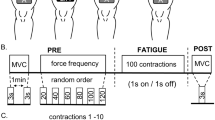Abstract
In the clinic, a major problem in train of four (TOF) muscle relaxation monitoring is incorrect placement of stimulation and recording electrodes, frequently resulting in incorrect estimates of the patient's degree of relaxation or in abandonment of relaxation monitoring. The aim of this study was to arrive at recommendations that describe how to find optimal positions for the electrodes, where ‘optimal’ is taken in the sense that small deviations from these positions introduce no or only a small decline in the accuracy of the computed degree of muscle relaxation. This study, which employed the Relaxograph as the stimulation and measuring device, established that incorrect positioning is a real problem that frequently occurs; that the correctness of positioning is not guaranteed when the calibration of the Relaxograph succeeds; that the inadequacy of the electrode position is sometimes discovered for the first time when relaxation deepens; that positioning errors can be discovered by analysing the shape of the evoked compound action potential (ECAP), not only upon calibration but also when relaxation deepens; that a set of optimal electrode positions can be found; and that recommendations of how to find these optimal positions could help clinicians to place the electrodes in such a way, that reliable relaxation monitoring was possible in 100% of the investigated cases.
In a first test in 30 adult patients, we surveyed how clinicians routinely positioned electrodes and found that in 14 of the 30 cases positioning was unsuccessful. In a second test in 10 patients, we tested a variety of electrode positions in order to discover ‘optimal’ stimulation, recording and ground electrode sites. In a third test in 10 patiens, electrodes were positioned at these ‘optimal’ sites; stimulation and recording at these sites was successful in all 10 cases.
Similar content being viewed by others
References
Ali HH, et al. Stimulus frequency in detection of neuromuscular blocks in humans. British Journal of Anaesthesiology 1970; 42: 967–977.
Ali HH, et al. Monitoring the neuromuscular function. Anesthesiology, 1976; 45(2): 216–234.
Anson BJ. Morris' Human Anatomy, a complete systematic treatise. 12th ed. The Blakiston Division, McGraw-Hill Book Company, N.Y. Toronto Sydney London, 1966: 509–514.
Brom RHG van den. Monitoring of neuromuscular transmission. Ph.D. thesis, University of Groningen, the Netherlands, 1994.
Gramstad L, et al. Neuromuscular blocking effects of atracurium, vecuronium and pancuronium during bolus and infusion administration. British Journal of Anesthesia 1985; 54: 1052–1059.
Kalli I. Monitoring of neuromuscular blockade by electromyography. Ph.D. thesis, Dept of Anesthesia, University of Helsinki, Finland, 1991.
Katz RL. Neuromuscular effects of d-tubocurarine, edrophonium and neostigmine in man. Anesthesiology 1967; 28: 327–336.
Nagasima H, et al. A simple method for monitoring muscular relaxation during continuous infusion of vecuronium. Canadian Journal of Anesthesia 1988; 35(2) 134–138.
Viby-Mogensen J. Clinical assessment of neuromuscular transmission. British Journal of Anaesthesia, 1982; 54: 209–221.
Author information
Authors and Affiliations
Rights and permissions
About this article
Cite this article
Smans, J., Korsten, H.H.M. & Blom, J.A. Optimal surface electrode positioning for reliable train of four muscle relaxation monitoring. J Clin Monit Comput 13, 9–20 (1996). https://doi.org/10.1007/BF02918207
Received:
Accepted:
Issue Date:
DOI: https://doi.org/10.1007/BF02918207




